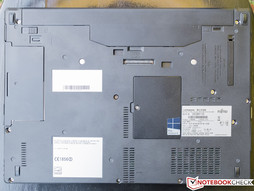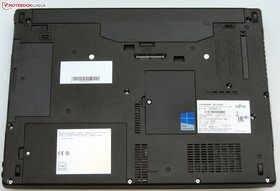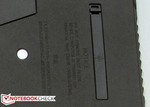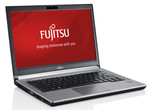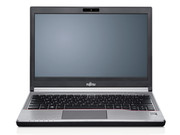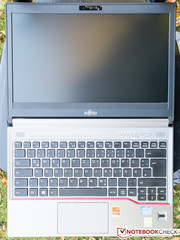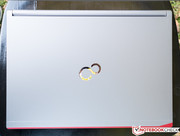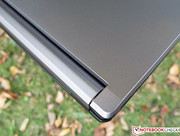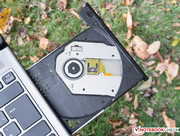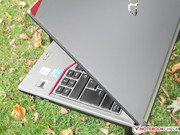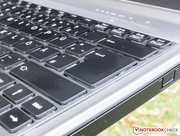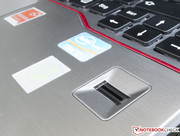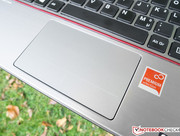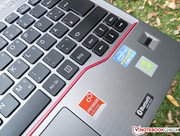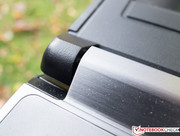Fujitsu Lifebook E734 (E7340MXEA1DE) Notebook Review Update

For the original German review, see here.
Following the 15.6-inch Lifebook E754 and 14-inch Lifebook E744, we now have our hands on the latest 13.3-inch Lifebook E734 from the Lifebook E line. Like its family members, the E734 is basically a Haswell-update. Our report outlines what benefits the laptop has from the new processors.
We used the Toshiba Portégé Z30-A-12U (Core i7-4500U, HD Graphics 4400) for classifying the laptop. The Portégé model that we tested is considerably pricier than the Lifebook and is also no longer available. However, configurations with a similar price exist; the Portégé Z30-A-12N sold for 1100 Euros (~$1495) is an example.
Since the Lifebook E734 features the same build as the Lifebook E733, we will not go in-depth about casing, input devices, connectivity or speakers. Corresponding information can be found in the review of the E733.
Case
Display
The 13.3-inch screen in the Lifebook has a matte surface. The screen's native resolution is 1366x768 pixels. Other screen models are not listed on Fujitsu's website. The screen's brightness of 181.3 cd/m² is disappointing. This low rate is not acceptable in a business laptop. We expect a minimum rate of 250 cd/m². The screen in the Portégé (264.9 cd/m²) is more convincing.
| |||||||||||||||||||||||||
Brightness Distribution: 82 %
Center on Battery: 202 cd/m²
Contrast: 232:1 (Black: 0.87 cd/m²)
ΔE ColorChecker Calman: 10.61 | ∀{0.5-29.43 Ø4.77}
ΔE Greyscale Calman: 10.76 | ∀{0.09-98 Ø5}
37% AdobeRGB 1998 (Argyll 1.6.3 3D)
40.25% AdobeRGB 1998 (Argyll 3D)
58.3% sRGB (Argyll 3D)
38.92% Display P3 (Argyll 3D)
Gamma: 2.53
CCT: 13274 K
The Lifebook's screen not only disappoints in terms of brightness but also with its contrast of 232:1 and black level of 0.87 cd/m². These poor rates are at the very most acceptable in budget laptops today. It is inconceivable how Fujitsu could install such an inferior screen in an 1100 Euros (~$1495) laptop. The Portégé's screen only supplies marginally better rates (338:1; 0.8 cd/m²).
The screenshots of the color-space reproduction prove that the Lifebook's screen cannot display either the sRGB or the AdobeRGB color space. It covers 53% of sRGB and 37% of AdobeRGB. The screen's average DeltaE 2000 shift in state of delivery is 10.76, which places the screen in line with most screens that we have assessed. Furthermore, the screen has a very clear bluish cast. A significant improvement can be achieved if the user can calibrate the screen. Our attempt resulted in a lower DeltaE 2000 shift of 3.55 (target range: DeltaE less than 3), and the bluish cast also disappeared.
The Lifebook's screen can only offer low brightness alongside a low contrast. Consequently, the laptop's outdoor suitability is restricted and would at the very most only be possible in not overly bright surroundings.
A TN screen is built into the Lifebook, and consequently the screen can only provide limited viewing angles. We noticed image distortions early, particularly horizontally. That is too bad because an IPS screen should actually be standard for a purchase price of almost 1100 Euros (~$1495).
Performance
Fujitsu's Lifebook E734 line makes compact, portable laptops in a 13.3-inch size available. Standard mobile processors provide the needed computing power (no ULVs). This fact can be called unusual because we normally find ULV CPUs in the 13.3-inch category. Naturally, the laptop also offers business features. For example, the docking port, the modular bay, and the LTE modem. Our review sample is sold for approximately 1100 Euros (~$1495). Other configurations are also available. A price of roughly 900 to 950 Euros (~$1223 to ~$1291) was charged for the lowest priced model (E7340M8501DE) at the time of writing.
Processor
The Lifebook is powered by a Core i5-4200M processor. This dual-core CPU is based on Intel's current Haswell architecture. It clocks with a base speed of 2.5 GHz, which can be increased up to 3 GHz (both cores) or 3.1 GHz (one core only) via Turbo. Intel specifies a TDP of 37 watts for the processor. The processor's full power can be retrieved in both AC and battery mode, as the Cinebench benchmark scores prove.
System Performance
The system ran smoothly, and we did not experience any problems. The good PCMark benchmark scores reinforce this subjective impression. The Lifebook achieved a very good score in the PCMark 7 test because it sports a hybrid hard drive (hard drive with incorporated SSD cache), and this test benefits greatly from that.
| PCMark 7 Score | 3777 points | |
| PCMark 8 Home Score Accelerated v2 | 2791 points | |
| PCMark 8 Creative Score Accelerated v2 | 2605 points | |
| PCMark 8 Work Score Accelerated v2 | 3884 points | |
Help | ||
Storage Devices
Fujitsu installs a hybrid hard drive from Seagate in the Lifebook. It has a capacity of 500 GB and spins with 5400 revolutions per minute. An incorporated 8 GB SSD cache supports the drive. The cache ensures that frequently used applications load faster. All in all, the drive delivers the rates that we expect from a 5400 rpm model nowadays.
Graphics Card
In conjunction with the Core i5 processor, the HD Graphics 4600 core has also moved into the Lifebook. The GPU supports DirectX 11.1 and works with speeds ranging from 400 MHz to 1150 MHz. The GPU does not exhibit any irregularities in the 3DMark benchmarks. The results are as we know from this graphics core.
| 3DMark 11 Performance | 1096 points | |
| 3DMark Ice Storm Standard Score | 53006 points | |
| 3DMark Cloud Gate Standard Score | 5384 points | |
| 3DMark Fire Strike Score | 682 points | |
Help | ||
Gaming Performance
The Lifebook laptops were not developed for computer games. Nevertheless, it is quite possible to play some games on the device. However, the user will have to be satisfied with low resolutions and quality settings. The laptop sports two working memory banks and thus operates in dual-channel mode. This makes better use of the GPU and provides higher frame rates than comparable models with only one memory module.
| low | med. | high | ultra | |
|---|---|---|---|---|
| Tomb Raider (2013) | 65.8 | 30.4 | 17.6 | |
| BioShock Infinite (2013) | 44 | 22.2 | 17.7 | |
| Thief (2014) | 19.1 | 11 | 9.1 |
| Fujitsu Lifebook E734 HD Graphics 4600, 4200M, Seagate ST500LM000 Solid State Hybrid Drive | Toshiba Portege Z30-A-12U HD Graphics 4400, 4500U, Toshiba HG5d THNSNH256GMCT | Fujitsu Lifebook E733-0MXP41DE HD Graphics 4000, 3632QM, Micron RealSSD C400 (MTFDDAK256MAM-1K12) | |
|---|---|---|---|
| Tomb Raider | -17% | -41% | |
| 1024x768 Low Preset (fps) | 65.8 | 49.9 -24% | 35.8 -46% |
| 1366x768 Normal Preset AA:FX AF:4x (fps) | 30.4 | 25.9 -15% | 18.3 -40% |
| 1366x768 High Preset AA:FX AF:8x (fps) | 17.6 | 15.7 -11% | 11.3 -36% |
Emissions
System Noise
The Lifebook is virtually silent during idle mode. The fan is inactive most of the time, and the hard drive is also almost inaudible. At the very most, a very quiet noise is heard. This quietness is over as soon as the laptop is demanded. The noise level increases to 36.7 dB in medium load (via 3DMark06) and 45.2 dB during full load in the stress test (Prime95 and Furmark run for at least one hour). The fan's annoyance potential is only minor during medium load. However, the fan's noise in full load reaches a level that no longer really allows for concentrated work.
Noise level
| Idle |
| 29.2 / 29.2 / 29.2 dB(A) |
| HDD |
| 29.2 dB(A) |
| DVD |
| 37.9 / dB(A) |
| Load |
| 36.7 / 45.2 dB(A) |
 | ||
30 dB silent 40 dB(A) audible 50 dB(A) loud |
||
min: | ||
Temperature
Like in both the Lifebook E754 and E744, the fan's much higher speed during full load also has a good side: The laptop only heated up moderately in the stress test. The Portégé was still a bit cooler than the Lifebook, which was due to the ULV processor in Toshiba's laptop.
The Lifebook exhibited the same behavior in both AC and battery mode during the stress test (Prime95 and Furmark run for at least one hour). The processor clocked with a speed of 2.5 GHz, and the graphics core worked with 850 to 900 MHz. The GPU's speed increasingly remained at 850 MHz the longer the test ran. The CPU's temperature settled to approximately 81 °C in the stress test.
(+) The maximum temperature on the upper side is 37.1 °C / 99 F, compared to the average of 35.9 °C / 97 F, ranging from 21.4 to 59 °C for the class Subnotebook.
(±) The bottom heats up to a maximum of 41.8 °C / 107 F, compared to the average of 39.3 °C / 103 F
(+) In idle usage, the average temperature for the upper side is 31.7 °C / 89 F, compared to the device average of 30.8 °C / 87 F.
(+) The palmrests and touchpad are reaching skin temperature as a maximum (35.9 °C / 96.6 F) and are therefore not hot.
(-) The average temperature of the palmrest area of similar devices was 28.2 °C / 82.8 F (-7.7 °C / -13.8 F).
Energy Management
Power Consumption
The Lifebook E734 has a positive trait in common with the larger Lifebook E744 and Lifebook E754 models: All three laptops have a low idle power consumption - which has to be praised. It is not surprising that the Portégé can even undercut these rates because it sports a ULV processor. The same behavior was observed during load.
| Off / Standby | |
| Idle | |
| Load |
|
Key:
min: | |
| Fujitsu Lifebook E734 HD Graphics 4600, 4200M, Seagate ST500LM000 Solid State Hybrid Drive | Toshiba Portege Z30-A-12U HD Graphics 4400, 4500U, Toshiba HG5d THNSNH256GMCT | HP ProBook 430-G1 HD Graphics 4400, 4200U, Hitachi Travelstar Z5K500 HTS545050A7E380 | Fujitsu Lifebook E733-0MXP41DE HD Graphics 4000, 3632QM, Micron RealSSD C400 (MTFDDAK256MAM-1K12) | |
|---|---|---|---|---|
| Power Consumption | 35% | 28% | -28% | |
| Idle Minimum * (Watt) | 4.7 | 3.5 26% | 3.9 17% | 7.3 -55% |
| Idle Average * (Watt) | 7.3 | 4.1 44% | 6 18% | 9.7 -33% |
| Idle Maximum * (Watt) | 8.5 | 7.1 16% | 8.3 2% | 12.7 -49% |
| Load Average * (Watt) | 42.3 | 27.3 35% | 23.9 43% | 42.3 -0% |
| Load Maximum * (Watt) | 59.4 | 27.6 54% | 25 58% | 62 -4% |
* ... smaller is better
Battery Runtime
The Lifebook achieved an idle runtime of 13:36 h. The Portégé (19:55 h) lasted considerably longer. Idle mode is ascertained using Battery Eater's Reader's test. The screen is set to minimum brightness, the energy-saving profile is enabled, and the wireless modules are turned off. The Lifebook shut down after 1:43 h of load. Again, the Portégé (2:19 h) lasted longer. The load runtime is checked with Battery Eater's Classic test. The screen's brightness is set to maximum, the high-performance profile is enabled, and the wireless modules are activated.
The Wi-Fi test stopped on the E734 after 6:20 h. Once again, Toshiba's laptop (7:37 h) reaped in a better runtime. Websites are opened automatically every 40 seconds in this test, the energy-saving profile is enabled, and the screen's brightness is set to approximately 150 cd/m².
The Lifebook can boast with decent battery runtimes. It is not surprising that it cannot keep up with the Portégé. The latter's ULV processor has lower power consumption than the one in the Lifebook and consequently achieves longer runtimes with a lower battery capacity.
| Fujitsu Lifebook E734 HD Graphics 4600, 4200M, Seagate ST500LM000 Solid State Hybrid Drive | Toshiba Portege Z30-A-12U HD Graphics 4400, 4500U, Toshiba HG5d THNSNH256GMCT | HP ProBook 430-G1 HD Graphics 4400, 4200U, Hitachi Travelstar Z5K500 HTS545050A7E380 | Fujitsu Lifebook E733-0MXP41DE HD Graphics 4000, 3632QM, Micron RealSSD C400 (MTFDDAK256MAM-1K12) | |
|---|---|---|---|---|
| Battery runtime | 34% | -9% | -13% | |
| Reader / Idle (h) | 13.6 | 19.9 46% | 11.2 -18% | |
| H.264 (h) | 6.6 | |||
| WiFi (h) | 6.3 | 7.6 21% | 4.3 -32% | 5.4 -14% |
| Load (h) | 1.7 | 2.3 35% | 2.1 24% | 1.5 -12% |
Verdict
Fujitsu's E734 represents an overall good compromise of portability, endurance, and computing power. Like the Lifebook E754 and E744 family members, not many modifications are found when compared with the precursor. Only a new processor generation has moved in. The Lifebook consumes less power and thus achieves longer battery runtimes owing to the Haswell architecture. However, we have to point out one drawback of the E734, similar to the E744: The screen. Fujitsu installs a dark, low-contrast, viewing-angle unstable screen with a bluish cast. A screen like that does not belong in a 1100 Euros (~$1495) laptop.
The advantages of Toshiba's Portégé Z30 are found in longer battery runtimes. Neither the Lifebook nor the Portégé belong to the low-budget laptop range. Therefore, we would lastly like to mention a fairly affordable 13.3-inch option: HP's ProBook 430 G1. The ProBook is a member of the entry-level business sector and does not feature a docking port or TPM. Nor should the user expect a high-quality metal casing. However, the laptop sports a UMTS module, which is not a matter of course in a laptop with a purchase price of approximately 660 Euros (~$897).


